The maze of beauty that entwines the hilltop town of Arezzo, nestled within a picturesque series of undulating valleys in eastern Tuscany, is due, in part to the striking Renaissance architecture that adorns this ancient settlement. However, originally colonised by the Etruscans almost three thousand years ago, the strategically located hilltop town became one of twelve Capita Etruriae, Etruscan capitals, bestowing upon it economic and religious wealth that secured the town’s prosperity and importance among the ancient Etruscan nobility. Arezzo became known throughout the ancient western world as an integral place of great artistry, exquisite beauty, and superior craftsmanship.


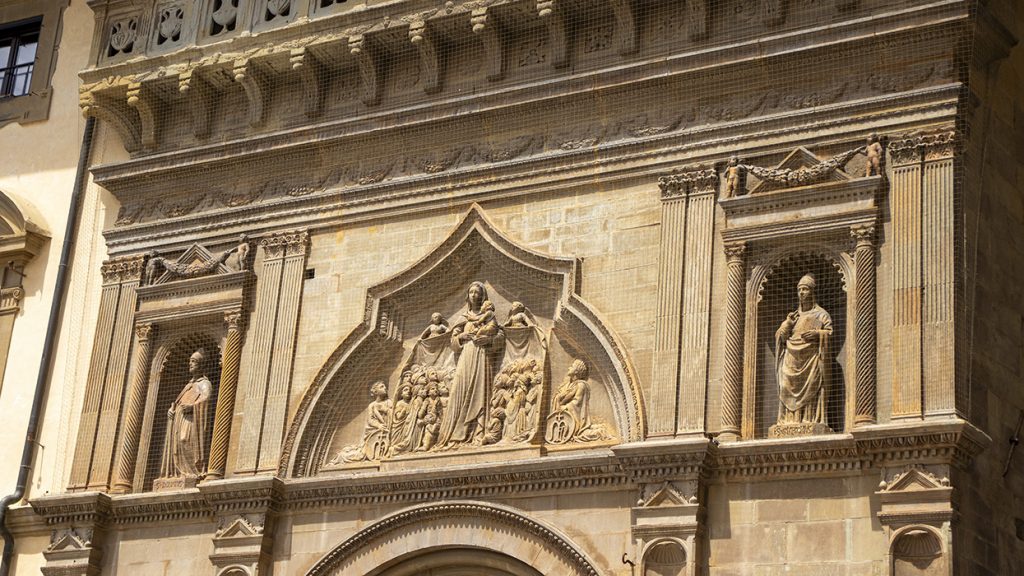
Yet, despite Arezzo’s ancient legacy and enormous historical clout, it is other, far more aesthetically attainable reasons that I venture here today. On my ever-expanding list of things to see in Italy and poised very close to the top, was the monthly antique market in Arezzo, held on the first Sunday of every month and, most obligingly, each preceding Saturday. Though not a serious antique collector, I simply appreciate beauty when I see it, and therefor revel wholeheartedly in the chance to spend a leisurely morning wandering Arezzo’s pretty alleyways in search of lovely old things – and maybe, just maybe, unearth a little something special in the process.


Apparently, the Arezzo Antique Market is still one of the biggest in Italy. Serendipitously, while re-reading Frances Mayes’ account of her envious life lived in the nearby Tuscan town of Cortona in her book Under the Tuscan Sun, Mayes mentions visiting the monthly Arezzo antique market in June, declaring it to be even more crammed with antiques and collectables than any other time of year. I’m in!


After visiting London’s Sunbury Antique Market on various occasions, I had very high expectations concerning the quality of antique fairs. Would this one in Arezzo meet my elevated standards now that I’d seen the very best?
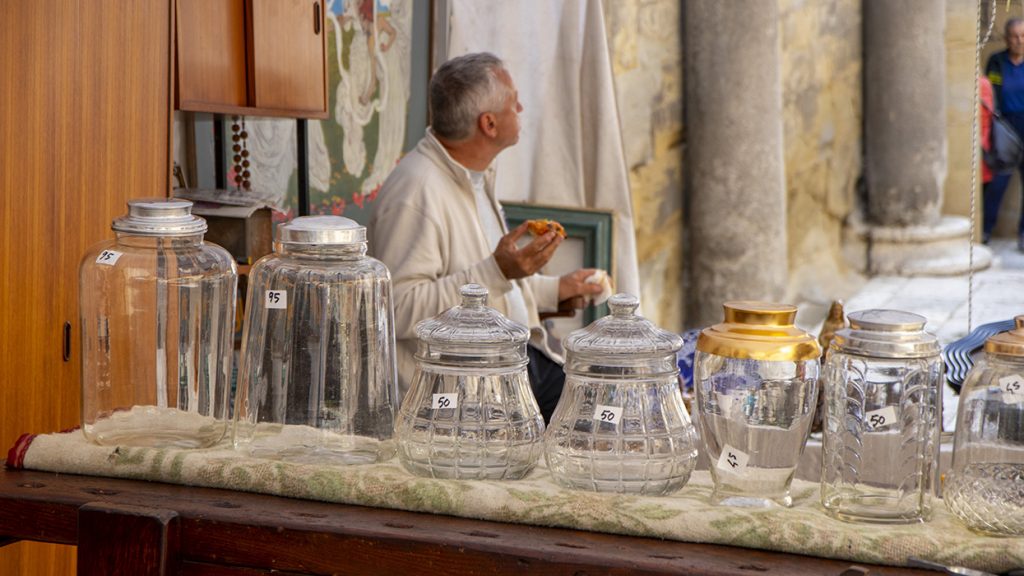
Alighting the early train from Florence we make the gentle 6-minute walk from the Arezzo train station towards the centre of the old town, wending our way past relatively modern buildings (by Italian standards) and the obligatory Zara department store, so omnipresent now in almost all Italian towns. The contemporary part of the town is soon superseded by time-worn terracotta brick walls. Their hand-crafted surfaces are rendered even more beautiful by their pock-marked exteriors, weathered by thousands of years of exposure to the unforgiving elements of the Tuscan landscape. As if on cue, rows of large folding tables are meticulously organised jowl to jowl along each side of the street. The patinated surfaces of these wooden tabletops are a reassuring indication of the market’s longevity, having prospered in the town since its inception in 1968.


Not every seller in the market has amassed a collection to rival the Victoria & Albert Museum, however, the traders here, no matter what rarities or objects they have accumulated, know exactly what they are selling and precisely how much it’s worth – relatively speaking, of course. All manner of bizarre objects and creatures soon appear. An impressively large crab – presumably relieved of his innards, is as real as the old gentleman who presides over his remarkable array of ancient fossils and glimmering old seashells, their smooth surfaces worn down from a life spent caressed by the Mediterranean Sea. The lifeless creature (the crab, not the old man) stares back at me – causing me to startle backwards into the chap behind me, much to the amusement of the elderly gent behind the counter. One gets the impression this pantomime happens on a regular occurrence, and I wonder if the crab is actually for sale or simply placed there for comedic effect. Perhaps to amuse himself for a moment while the crowds disperse for lunch.



Moving along from crustations of yesteryear, we ribbon our way upward, through the growing crush of antique-loving tourists and in-the-know Italians who frequent the market regularly, towards an unfolding, unending menagerie of delectable and unusual things. I pass an alluring table of old carved wooden picture frames, their gilded edges worn away with decades of human touch, like the well-read pages of a dogeared book. l voluntarily implore myself to restrain from purchasing such pictorial delights and am momentarily reassured when I gingerly ask the seller in my halting, Australian-accent-tinged-Italian what the cost of such exquisite craftsmanship costs. Out of my price range, so it seems. The Arezzo Antique Market is no bargain-basement car boot sale, yet there are real treasures to be found, and attained here by those of us not willing, or able, to part with considerate amounts of cash.




Snaking our way slowly uphill I soon realise the vastness of the market as tabletops spilling with gathered goods line the ancient town’s streets like soldier ants ferrying their precious, tiny cargo on their small but sturdy backs. Culminating in Piazza Grande, in the heart of the town, the stalls sprawl into every nook and cranny available that isn’t already monopolised by existing antique shops – Arezzo is already home to at least one hundred permanent brick and mortar antique shops – and a delicious array of local restaurants and eateries.




Some of the existing antique shops open their doors wide, gathering a selection of their furniture and wares out onto the footpath in the hope of luring those of us still desperate for more antiquing to venture forth inside. With so much to entice at eye level, I must remember to avert my gaze upwards to admire the splendid Renaissance architecture that so impressively dominates the square. Many of the building’s facades are adorned with brightly coloured shields, whose presence is a reminder of the Giostra del Saracino, a Medieval jousting tournament which still takes place twice a year, with the square as a backdrop to the armigers, horses and knights that battle here to commemorate the ancient combat of Arezzo against the Saracens.




Around five hundred exhibitors selling all manner of enticing objects d’art, furniture, paintings, books, historic prints, collectable toys, jewellery, ceramics, glass, fabrics, iron and copper objects, and unidentifiable-to-me-bric-a-brac that defies categorisation. I want to see it all, yet my brain is foggy, and my stomach is growling in defiance. This rumbling becomes an unworthy accompanist to a nearby celloist who’s dulcet symphony intoxicates the piazza with a sound so perfectly in tune with its historical surrounds.



With lunch and a well-deserved spritz in mind, we make our way towards the scent of what I hope is a hearty dish of pasta topped generously with slow cooked wild boar ragu. In our haste to eat early we’re able to pick a lovely outdoor table at the edge of the piazza, under the welcome shade of the towering, pale stone façade of the Basilica di San Francesco. I spy a dapper gent with a bushy, yet manicured beard sporting a rather expensive looking straw Panama hat loitering nearby and assume, most incorrectly, that he is setting up for some form of street performance show. Mesmerised by his resplendent attire, I sat frozen, gazing admiringly at his natural linen blazer and then down towards his wonderfully shocking-pink slacks. He looks like a particularly well-dressed exclamation point, so sharp and considered is his look. I realise, with much delight, that he’s an old-fashioned barber, setting up shop en plein air to offer passing gentlemen a cut-throat shave. I settle in for the spectacle, sipping slowly on my ice cold spritz while a small crowd gathers to watch the dapper barber in the shocking-pink pants.




Whilst enjoying the current spectacle in front of me I am reminded that Arezzo, with its rich and varied cultural history, is also home to great artistic lineage. Behind us sits the hulking Basilica of San Francesco, the interior of which is adorned by Arezzo’s own Piero Della Francesca’s fresco cycle The Legend of the True Cross. Vast in scale and exquisitely executed, an immense landscape with hundreds of intricately painted figures and lavishly decorated ornamentation, Piero Della Francesca’s fresco cycle is a masterpiece of light, colour, and perspective.




Wandering Arezzo’s charming streets today I see little evidence of the town’s original ancient colonisers, and what little remains of this once great and influential civilisation is now housed safely within the walls of the Archaeological Museum of Arezzo. Yet this small and bountiful vestige of those mythical Etruscans reveals outstanding beauty and cultural worth.
This museum is one of Italy’s most influential and important regional museums as it holds one of the greatest archaeological collections in Tuscany. Together with the Roman Amphitheatre, it recounts the story of a town whose ancient streets – those same weather-worn alleyways I tread today, stopping continuously to admire the abundance of Renaissance architecture – were ultimately paved with millennia of unfolding historical layers.


The museum is a cornucopia of significant treasures including elegant, intricately detailed jewellery from the urban Etruscan necropolis of Poggio del Sole, and the findings from the imposing sanctuary of Castelsecco, the main sanctuary outside the city, during the ancient Etruscan times, where sacred religious scenes were once re-enacted.
There is also a Roman section which houses a vast collection of terra sigillata vases, commonly referred to as ‘coral vases’ because of their coral red colour. Such tableware vases produced here in Arezzo during the Roman times enabled the city to become famous throughout the Roman Empire and beyond. These intricate vessels with sophisticated decoration techniques found their way across the continents even as far as India apparently.
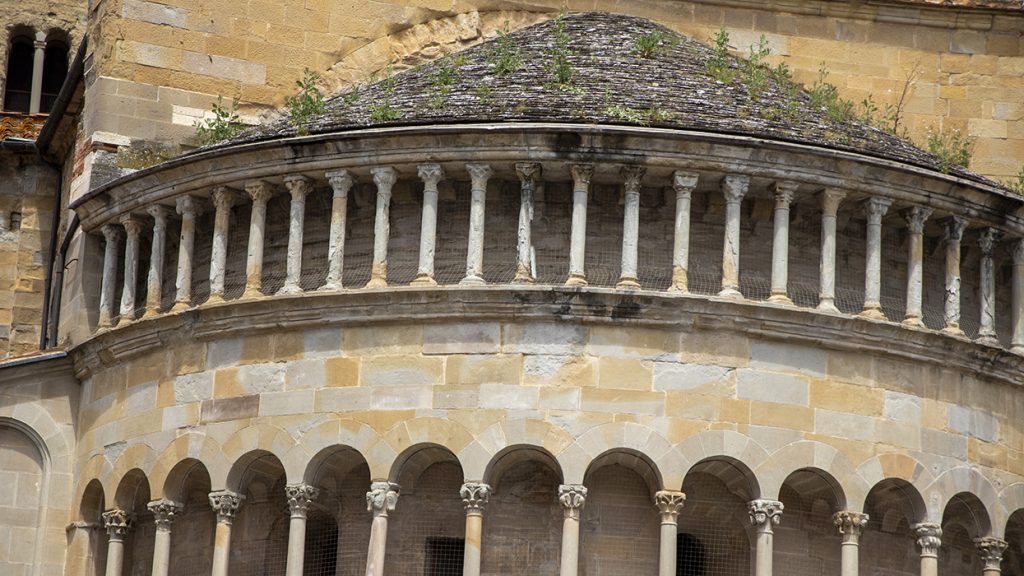
Recent excavation unearthed important ruins from an Etruscan necropolis on the Poggio del Sole (Hill of the Sun), some remnants now housed in the archaeological museum, yet it was the discovery of the Chimera and the Minerva bronze statues in the sixteenth century that are the real treasures of Arezzo’s ancient antiquities. The Chimera of Arezzo is one of the best known pieces of Etruscan sculpture to survive from this captivating period in the town’s history. Discovered in the sixteenth century near the Porta San Lorentino, an imposing Medieval gate leading into the old city, the statue was added to the collection of Cosimo I de’ Medici, Grand Duke of Tuscany, shortly after it was uncovered, and is currently housed in the Museo Archeologico Nazionale in Florence, the capital city’s impressive archaeological museum.
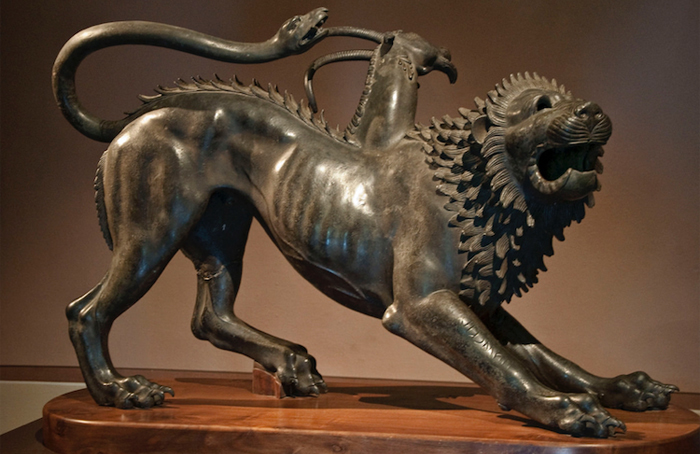
Arezzo was also the birthplace of the renowned painter and architect Giorgio Vasari, author of Lives of the Most Eminent Painters, Sculptors and Architects, first published in the sixteenth century in Florence, and touted as ‘perhaps the most important book on the history of art ever written’ by prominent art historians Peter and Linda Murray in the 1960’s, making Vasari the first art historian in the modern sense.
When the Chimera statue was discovered along with a collection of small bronzes, it was cleaned by Cosimo I and the artist Benvenuto Cellini (who created the spectacular bronze sculpture Perseus with the Head of Medusa that now resides in the Piazza della Signoria in Florence); it was then displayed as part of the duke’s collection in the Palazzo Vecchio in Florence. Vasari, with his immense skill as a sculptor and vast knowledge of historical painting and art, studied the statue and declared its antiquity to be authentic. A legendary, fire-breathing monster of Greek myth, the Chimera is a ferocious hybrid with the body and head of a lion, with a twisting goat rising from its back, and the tail of a snake in the throes of attacking its own tortured, amalgamated form.


There is so much ancient art and history to absorb and experience in Arezzo and it really cannot be explored fully in only the one day that we have allowed ourselves. Following our hearty lunch, we manage to tear ourselves away from the crowds in order to seek out some respite and shade, with a longing to further explore the more residential backstreets of this lovely town. A quick stroll from the main piazza brings us to quiet cobblestone streets, flower filled balconies and a very enticing restaurant where locals are enjoying a lazy Sunday pranzo. It is such an enchanting area and I find myself wishing I could stay here in Arezzo for a few more days. I will just have to return for another, much longer visit next time!




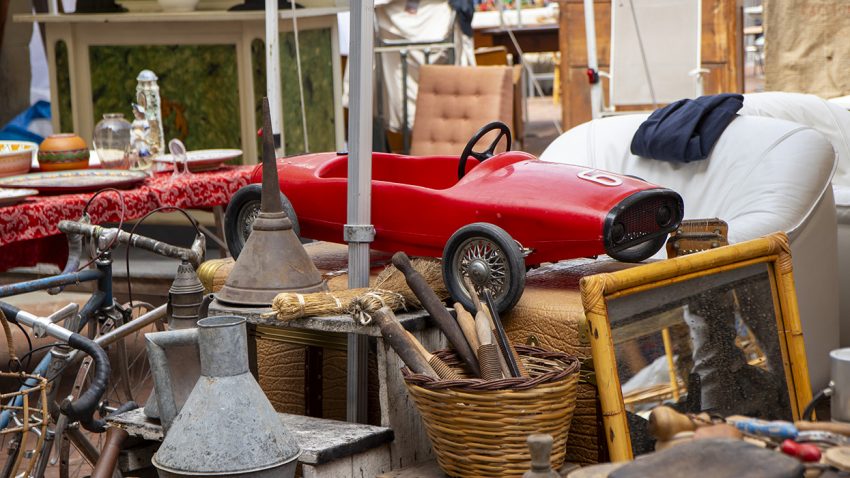
Thank you for sharing your impressions of Arezzo. We stumbled upon the antique market as well as a medieval festival there years ago. I loved looking through all the treasures but like you I left them for others to acquire. I remember having a spectacular lunch there. Maybe we’ll go back this fall.
Thank you Michelle, I’m so happy you enjoyed the read! Isn’t Arezzo a lovely little town. I think the Tuscan hilltop towns have to be some of my favourite in Italy. The medieval festival would have been such a treat, like being transported back to another time. I would definitely like to visit again one day when the antique market isn’t on, simply to enjoy the town as it usually is, and to appreciate the architecture without the distraction of the market stalls – as wonderful as they were! I hope you and your husband make it back in the fall!
Rose x
This lovely visit to Arezzo was such a wonderful experience and exceeded all my expectations. It was so nice to remember that wonderful Sunday again while reading your account and seeing your photos. The most amazing antique market! Would love to go back to Arezzo too.
What a fabulous experience it was! Especially as we were able to be there together. And it was worth lugging that antique French piece around for the next three weeks!;)
Let’s go back again – there’s so much more to explore.
Rose x
Thanks for recounting your experience so beautifully…..let’s hope the next adventure is not far away?
Norway?
Thanks Pippa! Glad you enjoyed the little tour. Actually, my husband and I are going to Vienna at Christmas to see his sister perform at the opera house there. His parents are coming from Australia too which is very exciting! I’ve always wanted to visit Vienna, especially at Christmas time.
Rose x
I’m so happy you’ve visited your beloved Italy again, Rose, and was particularly happy to read this wonderful account of your visit to Arezzo as this was where Kira spent a summer Uni semester a few years ago. I wasn’t able to visit her while she was there, but I would love to spend some time there one of these days. I will definitely be sharing this with her.
Thank you Terryl! I’m so happy you enjoyed the little tour to Arezzo, it’s such a gorgeous town. I didn’t realise Kira had attended Uni there, what a fantastic experience for her! I hope you can make it over there one day, maybe with your two beautiful girls – I know Nic would love it too.
Rose x
Hello Rose! I happened upon your wonderful articles several weeks ago and started following you. I loved this “tour” of Arezzo, a place on my bucket list.
My husband, John, and I were on Ciro’s and Victoria’s tour of Sicily with you and your mother several years ago — glad to know you’re you’re both doing well. Please give her our regards!
Hi Lynn! What a lovely message to receive! Can you believe that our trip to Sicily was 5 years ago now?! Incredible.
I’m so glad you enjoyed the tour around Arezzo Lynn, it’s such a beautiful town – and the antique market is heavenly! I hope you and John make it there one day. Please pass on my regards to John too!
Rose x
It must be such an exciting experience to visit such a vibrant place. Your photos are a feast for the eyes as you record an account of your adventure.